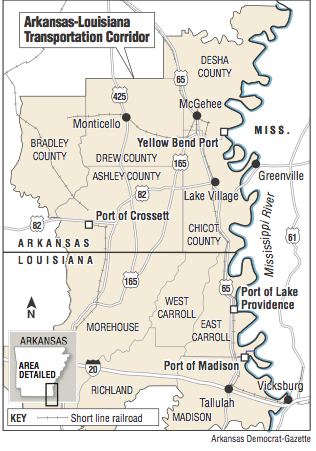MONTICELLO -- A rail line of only 90 miles would seem to be an apt metaphor for the tough times experienced over the past several decades by those in southeast Arkansas and northeast Louisiana.
The line is crooked in spots, where 5 mph is the norm, along the Northern Louisiana & Arkansas Railroad's 62-mile run from McGehee to Lake Providence, La. Tree limbs and brush scrape the sides of train cars traveling along the rails. The typical crew of two has plenty of time to gaze at abandoned grain bins covered in vines and pass through towns long past their glory days.
From 2007-16, parts of tracks for the short-line railroad with roots going back to 1878 were broken and all but unusable.
Improvements along the entire line -- itself a cooperative venture involving both states and several private ventures -- could be a sign of better things to come.
Any rivalries between the two areas must be cast aside for either one to grow, according to leaders of the latest economic-development effort there.
Bolstered this year by two grants totaling $1 million, including matching funds, the initiative is aimed at what the region has in common.
Five Arkansas counties and five Louisiana parishes make up the alphabet soup known as the ArkLaMEC, or Arkansas-Louisiana Multimodal Economic Corridor. The five counties in Arkansas are Ashley, Bradley, Chicot, Desha and Drew. The five parishes are East Carroll, West Carroll, Madison, Morehouse and Richland.
"None of these communities have really tried to address strategies on a regional basis, and that's not their fault," Jim Youngquist, executive director of the Institute of Economic Advancement at the University of Arkansas at Little Rock, said recently. "States tend to think the world ends at the state line."
The UALR institute and a similar entity at Louisiana Tech University in Ruston have taken leadership roles in getting the effort organized.
"We can't be the driver of this," Youngquist told some area leaders May 12 in Monticello. "Local leaders need to drive this."
The statistics
But the commonalities can be depressing.
The areas are among the poorest in their respective states, in jobs and in per-capita income.
The average unemployment rate in the five Arkansas counties is 5.6 percent, compared with the state average of 3.6 percent.
The five parishes in Louisiana average 9.7 percent unemployment, compared with the state average of 5.7 percent.
The areas in both states have lost population at roughly the same rates, largely as agriculture became more mechanized over the past several decades, requiring fewer workers.
The population in the five Arkansas counties combined hit a high of about 121,500 in 1940 but is now at about 74,000. The five Louisiana parishes also hit their population highs in the 1940s, with 120,350 residents. The total now is about 77,000 residents.
"Together, the region is obviously the Delta and primarily it's in agri-business," Youngquist told a reporter before the meeting. "Over the years, they've lost a lot of population. They've lost a lot of jobs. But, despite all that, they have a tremendous intermodal system of highways, rivers, ports and railroads."
The high points are:
• The Port of Crossett on the Ouachita River and the Yellow Bend Port near Arkansas City on the Mississippi River; and the Port of Lake Providence and Port of Madison Parish near Tallulah, on the Mississippi River in Louisiana.
• U.S. 65, 165 and 425, running from southeast Arkansas into northeast Louisiana where they tie into Interstate 20, which helps connect the eastern and western United States coasts; U.S. 82, which runs across southern Arkansas.
• Union Pacific and Kansas City Southern railroads, along with the Northern Louisiana & Arkansas short line. Two other short lines operate in the region: the Arkansas Midland, which runs for 51 miles between Warren and McGehee, primarily hauling timber; and the Delta Southern, which runs for 30 miles from Lake Providence to Tallulah.
Getting together
The Monticello meeting attended by Youngquist and two UALR colleagues also attracted representatives from Louisiana Tech's Innovation Center, the Southeast Arkansas Economic Development District in Pine Bluff, the Delta Regional Authority, the Arkansas Economic Development Commission, and the Port of Madison Parish and the Port of Lake Providence. Louisiana state economic development leaders listened by phone and watched by webcast. The Monticello Economic Development Corp. played host to the gathering.
"We started having small meetings of the rails and ports and economic leaders in Arkansas and in Louisiana about how to market ourselves regionally," Youngquist said. "Singularly, we don't stand a good fighting chance of getting jobs in there. But our ports, highways and rail all lead, one way or another, to Mexico and to the Pacific and Atlantic oceans."
While the most obvious and direct beneficiaries of any success will be farmers and others in agri-business, any progress also could provide "value-added" or related industry to benefit more people, Youngquist said. The western portions of Ashley and Bradley counties and Morehouse Parish are still heavy in timber, an industry that also could benefit from the two-state tag-team effort, he said.
A $100,000 grant awarded recently by the federal-state Delta Regional Authority will be used for a marketing campaign and startup money for the ArkLaMEC council, whose membership hasn't yet been fully lined out. The UALR and Louisiana Tech entities provided matching funds of $135,000.
An arm of the federal Department of Commerce also recently approved a $400,000 grant to the UALR and Louisiana Tech entities to develop a disaster response-and-recovery plan for the area. The two universities matched the federal money with another $400,000. Floods in late 2015 and early 2016 cut off the region's supply line for some 45 days.
State and federal money in 2014 helped extend rail service at the Lake Providence Port, providing better access to a bio-refinery operated by Myriant Corp. and to grain terminals operated by Bunge, and Big River Rice and Grain.
"The two states worked really well together on the (Northern Louisiana & Arkansas) rail, and I think that bodes well for what we're working on now," said Wyly Gilfoil, director of the Lake Providence Port.
Saving the line
Glenn Bell recently retired from the Southeast Arkansas Economic Development District after 45 years, including the past 30 years as director. With his retirement, Bell, who is widely credited for starting the ArkLaMEC effort, won't have an official role with whatever governing body is developed.
In 2005, Bell steered the development district into buying 22 miles of dilapidated rail, from Arkansas' Lake Village to the state line, that had been abandoned. It took years to raise the money to fix the rails and reopen the line, he said.
"We had to look beyond just a railroad and see it now as a 90-mile-long industrial park," Bell said recently by telephone while tending to his tomato garden. "Otherwise, all we're doing is stopping traffic in Lake Village."
When asked what could boost economic development in the region, he was quick to point to Mississippi County in northeast Arkansas, where steel mills line the river on land once heavily planted in cotton and soybeans.
"Steel didn't grow there," Bell said. "Steel is there because of the river."
Like Mississippi County, southeast Arkansas and northeast Louisiana have the acreage and the rivers for a steel plant. "I guarantee you that if a steel mill got put in, no matter what state it's in, it's going to draw workers from both states," Bell said.
Dan Robbins, vice president of the Russellville-based North Louisiana & Arkansas Railroad, said of Bell, "He saved that rail line."
Once rails and crossties are pulled up for scrap, "it's very difficult to put a railroad back in," Robbins said. "Glenn's move protected that entire line."
The North Louisiana & Arkansas Railroad owns 24 miles of the line from McGehee to Lake Village. It began operations in August 2011 and primarily hauls agricultural goods but also some petrol-chemical products.
"The two states got together," Robbins said. "We took over 24 miles that had been put up for abandonment. We got together with the port and the regional economic development districts, and took out lease agreements the rest of the way down."
Short-line railroads are Class 3 operations, meaning they have less than $20 million in annual operating income. "And believe me, the NLA is under $20 million," he said with a laugh.
The track is in "accepted" condition -- the lowest standard for a line to continue -- but progress keeps being made, Robbins said. The best section probably is from Lake Village to the Arkansas-Louisiana border and likely will be upgraded by federal regulators soon, he said.
A long-range plan is to build another short-line rail from McGehee to the Yellow Bend Port, but that will be expensive, Robbins said.
Robbins estimated that $14 million has been spent upgrading the entire 90-mile line, split equally between public and private interests. "That's still less than the cost of building a rail just 9 miles to Yellow Bend," he said.
Robbins said he has been impressed with the cooperation among the varied interests in the region and noted the distance from their respective state capitals. "It's a long ways up there from Baton Rouge, and it's a long ways down there from Little Rock," he said. "Working together, they stand a better chance [at success] than standing separately."
SundayMonday Business on 05/21/2017



